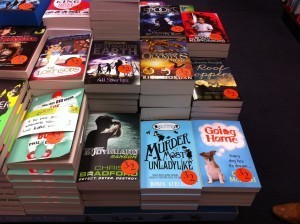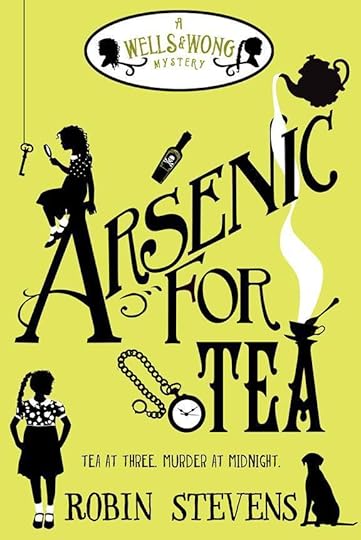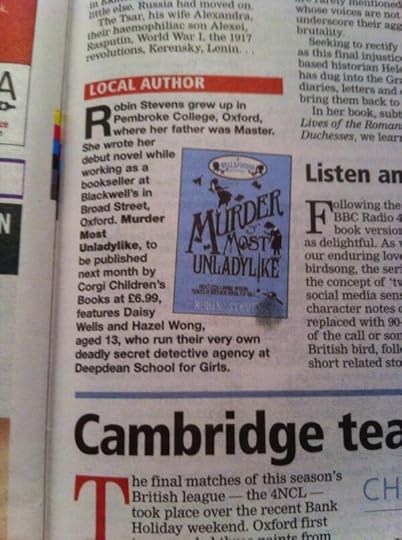Robin Stevens's Blog, page 69
June 6, 2014
Authoring: Day 1
Yesterday was the first day of Murder Most Unladylike‘s official release – and I couldn’t have had a better one. I didn’t just get to see my book on shelves, I got to see it sitting on the bestseller shelf in Blackwell’s Oxford. Thanks to all of you Oxford natives (and especially my mother), Murder Most Unladylike is currently top of the Blackwell’s Broad Street bestseller chart, and so when you go into the store, it’s sitting proudly on a shelf of its own.
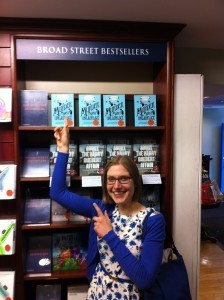
On the Blackwell’s Bestseller chart!
I’m so delighted – what an incredible thing to happen! I just stood and stared for a bit. It was also on a table in the Children’s section – look at the amazing company I’m in!
Then, as if that wasn’t exciting enough, I did my first ever author signing.
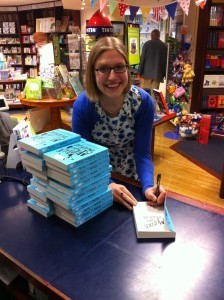
Signing!
Blackwell’s Oxford is being so supportive – they’re hosting a launch for me on the 28th, in fact, to which you are ALL invited – and I’m very glad to be able to say that they are now in possession of a VERY LARGE number of signed copies of Murder Most Unladylike. If you are anywhere near Oxford, do stop by and pick one up – and tell them I sent you!
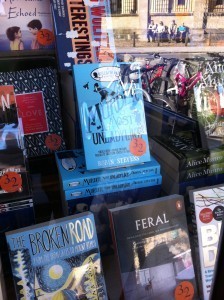
Signed copies in the window!
If I stay up on that bestseller slot for another week my face is going to be even more excited than this:
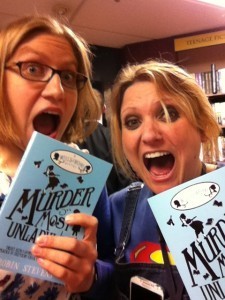
With bookseller extraordinaire Rebecca
June 5, 2014
Tea-Time Treat: Arsenic for Tea has a cover!
I’m delighted to be able to share with you a special publication day present from my wonderful publishers, Random House – the cover of the second book in the Wells & Wong Mystery series, Arsenic for Tea!
Isn’t it glorious? In real life, it will be a very fresh, zingy lime colour – perfect for afternoon tea!
There are so many gorgeous details – the tea cup! The watch! That bottle of poison! – but my absolute favourite thing is the dog. I am completely beside myself with joy at the fact that I will be an author of a book with a dog on the cover.
And in case you were wondering what the book was about apart from dogs, here’s the official description . . .
Schoolgirl detectives Daisy Wells and Hazel Wong are at Daisy’s home, Fallingford, for the holidays. Daisy’s glamorous mother is throwing a tea party for Daisy’s birthday, and Daisy’s eccentric family are all invited.
Then one of their party falls seriously, mysteriously ill – and everything points to poison.
With furious storms preventing anyone from leaving, or the police from arriving, Fallingford suddenly feels like a very dangerous place to be. No one at Fallingford is what they seem – and everyone has a secret or two. And when someone very close to Daisy looks suspicious, the Detective Society must do everything they can to reveal the truth . . . no matter the consequences.
You can even pre-order now from Blackwell’s, Waterstones or Amazon. How exciting!
Welcome to the world, Wells & Wong!
It’s official! Murder Most Unladylike is out in the UK and Ireland today, and I am a published author.
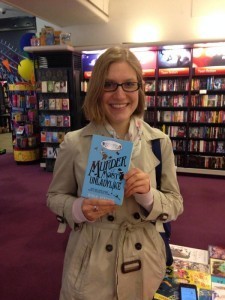
With the book at Waterstones Piccadilly
I had my first sighting of the book in the wild yesterday, at Waterstones Piccadilly. It was on a table, and on the shelf, and seeing it (and watching my friend buy a copy) finally made it seem real. It’s an object! It costs money! You can purchase it!
Quite obviously, if you do feel moved to buy a copy today (or tomorrow, or any day) you’ll make me a very happy author. You’ll make me equally happy if you buy the print or the ebook edition – to me, it’s all the same words on a page.
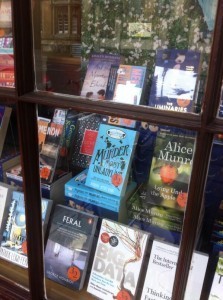
The window at Blackwell’s Oxford
But if you do want to get a physical copy, it would mean something extra-special to me (and to the whole book industry) if you went out and bought it from a real, honest-to-goodness bookshop. We all – readers and authors – need bookshops. A good bookseller is worth a hundred tailored mailings, and the discoveries you can make while you’re standing in a real bookshop can never be replicated on the internet. If you love reading, you should be supporting places that give books space and time. And it’s not as though you can’t pick up good bargains in bookshops. I know for a fact that Murder Most Unladylike is currently on 3 for 2 in Blackwell’s – and if you need some books to go with it, may I suggest some of the other excellent titles out today?
So quick! To your local bookshop! And if you happen to come upon Murder Most Unladylike – or if, even better, you buy a copy and have a #bunbreak with it – I’d love to hear from you or see your pictures.
In the meantime, I leave you with this – an exclusive Wells & Wong short story on the We Love This Book website. Can Hazel and Daisy solve the Case of Lavinia’s Missing Tie?
Happy 5th of June!
May 28, 2014
Murder Most Unladylike Goes Down the Rabbit Hole
On Tuesday, Down the Rabbit Hole, a new half-hour radio show entirely about children’s and YA books, aired on Resonance FM in a regular slot for the first time. Presented by Melissa Cox and Katherine Woodfine and featuring special guests Susie Day and Tom Percival, the three books discussed were Tiny: The Invisible World of Microbes, Lobsters . . . and Murder Most Unladylike.
I’m utterly bowled over that the book was chosen – and that it was such a big part of the show. Susie read an extract from it, the whole panel discussed it, and they even mentioned bunbreak. It’s the most amazing pre-publication present I could have been given.
You can listen to the show in full via SoundCloud, below. And you should!
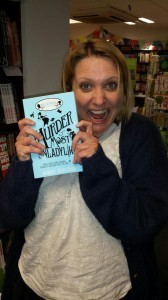 In other news, I can finally confirm that Murder Most Unladylike is 100% IN STOCK at Blackwell’s Oxford – fetchingly modeled here by ace children’s bookseller Rebecca.
In other news, I can finally confirm that Murder Most Unladylike is 100% IN STOCK at Blackwell’s Oxford – fetchingly modeled here by ace children’s bookseller Rebecca.
It’s also on offer at 3 for 2 – so if you’re in the area, stop by and tell them I sent you!
May 26, 2014
Countdown to Bunbreak: Ten Days!
Hello!
Good news first: Murder Most Unladylike will be out in TEN DAYS.
TEN DAYS. That’s less than two weeks. I couldn’t even hatch a duck egg in ten days. Ten days is PRACTICALLY NEGLIGIBLE.
In fact, for some of you lucky people, I’m hearing that the wait may already be over. Sources* (*acclaimed sleuth and Mystery Girl Kate Pankhurst) have told me that certain bookshops have begun to sell Murder Most Unladylike. I think this is still fairly rare – although it’s not embargoed, most stock won’t have been delivered yet, and even if the book is in, most shops like to hold back on new titles until a few days before release – but if you ARE lucky enough to find a copy of Murder Most Unladylike in the wild from now on, I want to hear from you.
Take a picture of yourself enjoying a bunbreak with Hazel and Daisy, email it to me or tweet me @redbreastedbird (tagged with #bunbreak of course), and I’ll feature the best on this site. I’ll also be eternally grateful to you because you’ll basically be giving me the best present a writer could wish for: proof that someone out there is actually reading my words.
And talking about people reading my words . . .
***
My Countdown to June 5th interview at the Cait Files is now up! Follow that link to find out all about my research process, my favourite children’s books and what I’d pick for my ideal bunbreak. And if you’re interested in reading interviews with the others fantastic authors involved in the project (you should be!), go to countdownya.com for the very latest round-up.
***
I’m also greatly honoured (and overwhelmed, and amazed) to be able to say that Murder Most Unladylike has been reviewed in the Financial Times by Suzi Feay. A shortened version of the review is up in the reviews section, but here’s photographic proof of the article in all its glory:
And there was also an amazing mention for Murder Most Unladylike the Oxford Times. The article speaks the truth: Blackwell’s Oxford has a lot to answer for. In fact, they’re so nice that they’re letting me have a launch event at their Broad Street store on the evening of Saturday the 28th of June. Please stop by if you’re in the area!
So, that’s my round-up! The next time I post on this blog I think I might finally be a published author.
I’m excited and very nervous, but trying to stay calm by reminding myself that, when it all seems too much, I need to just stop and have a bunbreak. It’s what Daisy and Hazel would do.
May 14, 2014
The Financial Times review
‘Stevens’ novel, set in the 1930s, is a skilful blend of golden era crime novel and boarding school romp, with a winning central relationship between plump, anxious Hazel, a new girl who has arrived from Hong Kong, and the super-confident, blonde English rose Daisy Wells. The novel works both as an affectionate satire and an effective mystery story, and Stevens can go places Enid Blyton never dreamt of, with lesbian teachers, drunkenness and hysteria amid the hockey sticks and buns. Top class.’
(Suzi Feay, The Financial Times)
May 8, 2014
The Novel Cafe review
‘This book had a strong first chapter which kept me glued to the book, wanting to read on . . .
I tried to guess who the murderer was . . . but didn’t get it right!, until the book revealed a twist in the tale.
It’s the best book I have read in a long time and I can’t wait for another adventure. I would definitely recommend you to read this book!’
May 5, 2014
Countdown to June 5th
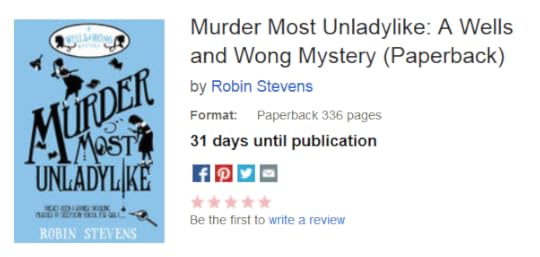 The countdown on the Waterstones website doesn’t lie: there is just ONE MONTH left until Murder Most Unladylike‘s official release. I feel unbelievably excited, and also slightly ill.
The countdown on the Waterstones website doesn’t lie: there is just ONE MONTH left until Murder Most Unladylike‘s official release. I feel unbelievably excited, and also slightly ill.
In a recent bit of rather exciting news, Murder Most Unladylike was featured in the Telegraph‘s book review section yesterday, as part of Lorna Bradbury’s pick of the best crime fiction for children. I showed the piece to my mother, and she said, “I’m hyperventilating,” which is how I feel too.
Now, to calm my nerves and help pass the time until June 5th, I’m taking part in the fantastic Countdown to 5th June project from YA Yeah Yeah, which matches authors with books coming out on June 5th with bloggers to talk about their books. There’s new content every day from a huge number of awesome authors (the best way to find it is to follow the @countdownya account on Twitter) – if you love kidlit, it’s a must-read. I’ve been paired with Cait Lomas of The Cait Files, and the interview I did with her will appear on her site on Saturday 24th May.
I’ll also be appearing in various exciting places across the internet to talk about the book in the run-up to its release date – I’ll post links once the interviews are up, so keep checking back here throughout May!
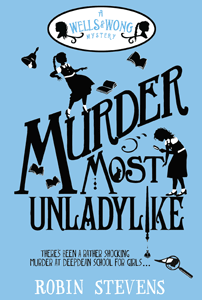 And now, to celebrate the fact that it’s a Bank Holiday, and my book comes out in ONE MONTH, I have a competition for you. Up for grabs is one finished copy of Murder Most Unladylike – the actual book that will be in shops on June 5th.
And now, to celebrate the fact that it’s a Bank Holiday, and my book comes out in ONE MONTH, I have a competition for you. Up for grabs is one finished copy of Murder Most Unladylike – the actual book that will be in shops on June 5th.
Murder Most Unladylike is a murder mystery, but it’s also a school story, and to celebrate that fact I’m asking you to leave a comment for me, below, to tell me the strangest nickname you and your friends gave to a teacher when you were at school.
The competition is open now, and will close at noon on Monday 12th May, when I’ll pick my favourite. Unfortunately, it is only open to readers in the UK and Ireland (not because I don’t love my American readers, but because there will be a US edition next year, and I’ll be running another one of these giveaways specifically for the US at that point). I will also not accept any entry that is actually offensive (slightly rude is fine; bizarre is positively encouraged).
So, what are you waiting for? Comment! And roll on the 5th of June.
May 4, 2014
The Telegraph review
“The book that has given me most pleasure is a first novel by Robin Stevens, Murder Most Unladylike (Corgi, published next month), which combines the pleasures of Enid Blyton’s boarding school books with her secret society ones. Best friends Daisy Wells and Hazel Wong find themselves at the heart of a murder investigation when Hazel discovers the body of a teacher in the school gym.
Plotting is what sets this book apart; this is about who was where at the time of the murder, and it’s about finding the chink in the alibi. Stevens’s duo – Daisy, who hides her sharpness under a chummy exterior, and Hazel, recently arrived from Hong Kong and out of place in an English boarding school – are interesting enough to hold up a second volume.”
April 25, 2014
We Need to Talk About Kidlit
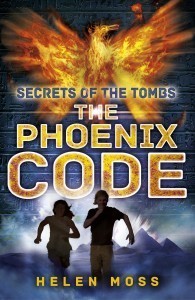
This kind of relentlessly girly book is RUINING children’s publishing
Last week The Times ran a delightful article entitled ‘It’s no wonder boys aren’t reading – the children’s book market is run by women‘. As a woman who works in children’s publishing (and who writes children’s books), you can bet I have deep, strong feelings about this statement. Yes, boys don’t read as much as girls. Yes, this is a puzzle and a problem – for publishers and authors as much as for parents and teachers. But blaming publishers for being too girly is simply not a sensible response.
I’m female, after all, and I work in publishing, and my favourite things are a) dragons b) magic c) murder d) cool superheroes blowing stuff up and being awesome. I love facts. I hate books that start slowly. A straight romance plot has to be really good to get me interested. I’m quite clearly not the stereotypical female publisher of that Times article. And if I’m not, why should anyone else be?
As a genuine response to the question of why boys don’t read as much, I don’t think that article should be given the time of day. But what I am interested in is what it reveals about all the unconscious assumptions our culture currently has about what is feminine and what is masculine. And I wonder whether this may have something to do with why boys as a group don’t seem to be as excited about books as girls.
Let’s accept for a moment that Jonathan Emmett’s assertion that girls and boys don’t have overlapping interests is true. Girls like friendship and emotions, while boys like fighting and facts. It follows, therefore, that any book with an emotional aspect to it must be a book for girls. If it’s not just a punch-fest, it can’t be of real interest to boys. And of course, any book in which a girl features prominently certainly can’t be for boys.
And, to my mind, this is (part of) the answer to why boys don’t read as much as girls. This is where we’re going wrong – and going more wrong now, I think, than we were when I was a child. On some level, we are now expecting boys not to be able to cope with books that are not exclusively about a certain very stereotypical vision of boyishness, and so we’re not even recommending other types of writing to them.

It’s not just for girls
I know I’m not just imagining this because of a phone call I had with my mother last week.
“Robin,” she said, very doubtfully. “Could I give your book to a boy?”
“How old is he?” I asked.
“Ten,” she said.
“Then of course you could!” I said.
“But -” said my mother. “He’s a boy!”
I pointed out to her that if the boy in question could not look past my two girl detectives to the really cool murder mystery they’re investigating, then there was very little hope that he would grow up to be a fully rounded human being able to cope with the world. The thing is, my mother wasn’t trying to be sexist. She just expected that a boy would have trouble with a book about girls. And if my mother (a feminist who raised me to be the same) could think that, it’s fair to assume that this is something almost all of us are guilty of. In a million tiny ways, I think we are censoring what reading material we offer to boys – and with such a small pool of acceptable literature to choose from, it’s not surprising that they’re turning to things like TV and computer games that offer them a wider range of acceptable stories.
This isn’t good enough. This isn’t fair to boys or girls. We need to do better. We’re getting better at reminding girls that they can be whatever they want to be, and read whatever they want to read, but this needs to cut both ways. After all, there’s no point raising awesome, open-minded women if at the same time we’re raising men who can’t cope with them.
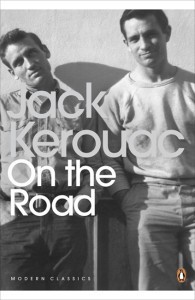
It’s not just for boys
When I was a kid I read a lot of books about girls, and a lot of books about boys – and I was fascinated by what I discovered about the way boys interact when girls aren’t around. As a teenager, one of my favourite books was On The Road for exactly that reason. I felt like I was seeing a world that was totally alien to me, and I loved it.
Isn’t one of the principal joys of fiction allowing yourself to see the world in a brand-new way? If so, why are we assuming that we need to protect boys from that experience? Why don’t we want to let them discover what it’s like to be girls for a few hours? What’s the problem with showing them that boys and girls aren’t really so different anyway?
I wrote Murder Most Unladylike about girls. But it’s not just for girls. That would be nuts. Its a book. If boys want to read it, they should. I just hope the adults around them will let them make that choice.

